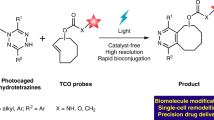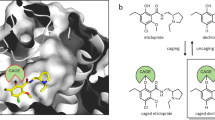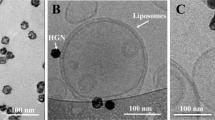Abstract
This protocol describes a method for efficient chemical synthesis of an analog of inositol-1,4,5-trisphosphate (IP3) hexakis acetoxymethyl ester having an ortho-nitroveratryl photochemical caging group on the 6-hydroxyl position. The six esters render the probe membrane permeant, such that it can be loaded into intact living cells in vitro or in vivo. Inside cells, the caged IP3 is inert until activated by two-photon excitation at 720 nm. The photoliberated signaling molecule can mobilize release of Ca2+ from intracellular stores on the endoplasmic reticulum. When co-loaded with the fluorescent Ca2+ indicator rhod-2, one laser can be used for stimulating and monitoring intracellular Ca2+ signaling with single-cell resolution. This protocol has chemistry and biology sections; the former describes the organic synthesis of the caged IP3, which requires 12 d, and the latter an application to a day-long study of astrocyte-regulated neuronal function in living brain slices acutely isolated from rats. As Ca2+ is the single most important intracellular second messenger and the IP3-Ca2+ signaling cascade is used by many cells to produce increases in Ca2+ concentration, this method should be widely applicable for the study of a variety of physiological processes in intact biological systems.
This is a preview of subscription content, access via your institution
Access options
Subscribe to this journal
Receive 12 print issues and online access
$259.00 per year
only $21.58 per issue
Buy this article
- Purchase on SpringerLink
- Instant access to full article PDF
Prices may be subject to local taxes which are calculated during checkout






Similar content being viewed by others
References
Ellis-Davies, G.C.R. Caged compounds: photorelease technology for control of cellular chemistry and physiology. Nat. Methods 4, 619–628 (2007).
Miesenbock, G. & Kevrekidis, I.G. Optical imaging and control of genetically designated neurons in functioning circuits. Annu. Rev. Neurosci. 28, 533–563 (2005).
Ellis-Davies, G.C.R. Neurobiology with caged calcium. Chem. Rev. 108, 1603–1613 (2008).
Kasai, H. Comparative biology of Ca2+-dependent exocytosis: implications of kinetic diversity for secretory function. Trends Neurosci. 22, 88–93 (1999).
Sorensen, J.B. Formation, stabilisation and fusion of the readily releasable pool of secretory vesicles. Pflugers Arch. 448, 347–362 (2004).
Becherer, U. & Rettig, J. Vesicle pools, docking, priming, and release. Cell Tissue Res. 326, 393–407 (2006).
Tsien, R.Y. Fluorescent probes of cell signaling. Annu. Rev. Neurosci. 12, 227–253 (1989).
Grynkiewicz, G., Poenie, M. & Tsien, R.Y. A new generation of Ca2+ indicators with greatly improved fluorescence properties. J. Biol. Chem. 260, 3440–3450 (1985).
Engels, J. & Schlaeger, E.J. Synthesis, structure, and reactivity of adenosine cyclic 3′,5′-phosphate benzyl triesters. J. Med. Chem. 20, 907–911 (1977).
Svoboda, K. & Yasuda, R. Principles of two-photon excitation microscopy and its applications to neuroscience. Neuron 50, 823–839 (2006).
Ellis-Davies, G.C.R. A practical guide to the synthesis of dinitroindolinyl-caged neurotransmitters. Nat. Protoc. 6, 314–326 (2011).
Gordon, G.R., Choi, H.B., Rungta, R.L., Ellis-Davies, G.C.R. & MacVicar, B.A. Brain metabolism dictates the polarity of astrocyte control over arterioles. Nature 456, 745–749 (2008).
Gordon, G.R. et al. Astrocyte-mediated distributed plasticity at hypothalamic glutamate synapses. Neuron 64, 391–403 (2009).
Kantevari, S. et al. Synthesis and two-photon photolysis of 6-(ortho-nitroveratryl)-caged IP3 in living cells. Chembiochem 7, 174–180 (2006).
Crowe, S.E., Kantevari, S. & Ellis-Davies, G.C.R. Photochemically initiated intracellular calcium astrocytic waves in living mice using two-photon uncaging of IP3. ACS Chem. Neurosci. 1, 575–585 (2010).
Dakin, K. & Li, W.H. Cell membrane permeable esters of D-myo-inositol 1,4,5-trisphosphate. Cell Calcium 42, 291–301 (2007).
Acknowledgements
This work was supported by a grant from US NIH (GM53395) to G.C.R.E.-D. B.A.M. is a Canada Research Chairperson, and the acute slice work was supported by an operating grant from the Canadian Institutes of Health Research. G.R.J.G. is supported by the Alberta Heritage Foundation for Medical Research, the Michael Smith Foundation for Health Research and the Natural Sciences and Engineering Council of Canada.
Author information
Authors and Affiliations
Contributions
S.K. prepared the caged compound. S.K. and G.C.R.E.-D. characterized the caged compound. G.C.R.E.-D. analyzed the NMR spectra. G.R.J.G. performed the cellular uncaging experiment. G.C.R.E.-D. wrote the paper with help from B.A.M. and G.R.J.G.
Corresponding author
Ethics declarations
Competing interests
The authors declare no competing financial interests.
Rights and permissions
About this article
Cite this article
Kantevari, S., Gordon, G., MacVicar, B. et al. A practical guide to the synthesis and use of membrane-permeant acetoxymethyl esters of caged inositol polyphosphates. Nat Protoc 6, 327–337 (2011). https://doi.org/10.1038/nprot.2010.194
Published:
Issue Date:
DOI: https://doi.org/10.1038/nprot.2010.194
This article is cited by
-
Mathematical investigation of IP3-dependent calcium dynamics in astrocytes
Journal of Computational Neuroscience (2017)
-
Cellular delivery and photochemical release of a caged inositol-pyrophosphate induces PH-domain translocation in cellulo
Nature Communications (2016)
-
A practical guide to the synthesis of dinitroindolinyl-caged neurotransmitters
Nature Protocols (2011)
Comments
By submitting a comment you agree to abide by our Terms and Community Guidelines. If you find something abusive or that does not comply with our terms or guidelines please flag it as inappropriate.



